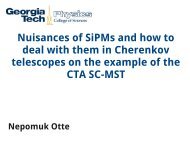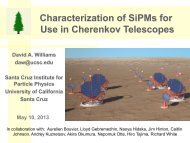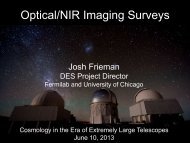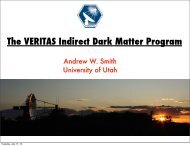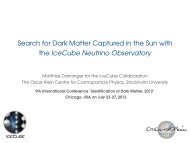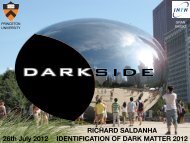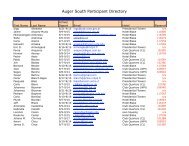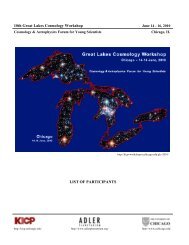The galaxy bispectrum: cosmology & primordial ... - KICP Workshops
The galaxy bispectrum: cosmology & primordial ... - KICP Workshops
The galaxy bispectrum: cosmology & primordial ... - KICP Workshops
You also want an ePaper? Increase the reach of your titles
YUMPU automatically turns print PDFs into web optimized ePapers that Google loves.
<strong>The</strong> Galaxy Bispectrum:<br />
Cosmology & <strong>primordial</strong> non-Gaussianity<br />
Emiliano Sefusatti<br />
Center for Particle Astrophysics, Fermilab<br />
<strong>KICP</strong>, Chicago, June 8 th , 2007<br />
E. S. & E. Komatsu (2007)<br />
E. S., H. M. Crocce, S. Pueblas & R. Scoccimarro (2006)<br />
E. S. & R. Scoccimarro (2005)<br />
R. Scoccimarro, E. S. & M. Zaldarriaga (2004)
<strong>The</strong> <strong>galaxy</strong> <strong>bispectrum</strong>: theory and observations<br />
1982, CfA Redshift Survey<br />
∼ 1, 000 galaxies<br />
⇒ large-scale clustering<br />
[Baumgart & Fry (1991)]<br />
1995, IRAS PSCz Redshift Survey<br />
∼ 15, 000 galaxies<br />
⇒ <strong>galaxy</strong> bias, <strong>primordial</strong> non-Gaussianity<br />
2/19<br />
[Fry & Scherrer (1994), Matarrese et al. (1997), Verde et al. (2000), Feldman et al.<br />
(2001), Scoccimarro et al. (2001)]<br />
2002 to the present, 2dFGRS and SDSS<br />
∼ 250, 000 to 1, 000, 000 galaxies<br />
⇒ halo model<br />
[Verde et al. (2002), Gastañaga et al. (2005), Nishimichi et al. (2006), Kulkarni et al.<br />
(2007)]<br />
What about cosmological parameters? What are the prospects for <strong>primordial</strong><br />
non-Gaussianity?
Higher order correlators as probes of non-linear physics<br />
Contributions to the <strong>galaxy</strong> <strong>bispectrum</strong>:<br />
• Gravitational instability<br />
δm<br />
PT δL + δ (2) + ..., ⇒ Bm(k1, k2, k3) = BG(k1, k2, k3)<br />
• Non-Gaussian initial conditions due to non-linearities in the inflationary dynamics and<br />
in the super-horizon evolution<br />
• Galaxy bias<br />
N.G. I.C. ⇒ Bm(k1, k2, k3) = BI(k1, k2, k3) + BG(k1, k2, k3)<br />
δg(x) b1δm(x) + b2<br />
2 δ2<br />
m (x)<br />
⇒ Bg(k1, k2, k3) = b 3<br />
1 Bm(k1, k2, k3) + b2 b 2<br />
1 [P (k1)P (k2) + cyc.]<br />
Bg(k1, k2, k3) = b 3<br />
1 [BG(k1, k2, k3) + BI(k1, k2, k3)] + b2 b 2<br />
1 Σ(k1, k2, k3)<br />
• Can we tell them apart?<br />
• How well can we measure them?<br />
3/19
Signal-to-noise for matter correlators: the SDSS case<br />
Sum over all configurations up to kmax<br />
E.S. & R. Scoccimarro (2005)<br />
Ideal Geometry<br />
variance only<br />
V = 0.3 h −3 Gpc 3<br />
¯n = 0.003( h −1 Mpc) −3<br />
„ S<br />
N<br />
„ S<br />
N<br />
„ S<br />
N<br />
« 2<br />
P<br />
« 2<br />
B<br />
« 2<br />
eT<br />
=<br />
=<br />
=<br />
Z<br />
eT (k1, k2, k3, k4) ∼<br />
kmax X<br />
k<br />
kmax X<br />
triangles<br />
kmax X<br />
quads<br />
P 2<br />
∆P 2<br />
B 2<br />
∆B 2<br />
eT 2<br />
∆ e T 2<br />
4/19<br />
dΩT (k1, k2, k3, k4)
Signal-to-noise for matter correlators: the SDSS case<br />
Sum over all configurations up to kmax<br />
E.S. & R. Scoccimarro (2005)<br />
Ideal Geometry<br />
variance only<br />
V = 0.3 h −3 Gpc 3<br />
¯n = 0.003( h −1 Mpc) −3<br />
SDSS geometry<br />
+ covariance matrices<br />
from 6000 2LPT realizations<br />
„ S<br />
N<br />
« 2<br />
B<br />
=<br />
kmax X<br />
triangles i,j<br />
Cij ≡ 〈δBiδBj〉<br />
Bi C −1<br />
ij Bj<br />
5/19
Cosmological parameters from a joint analysis<br />
of power spectrum and <strong>bispectrum</strong><br />
E. S., H. M. Crocce, S. Pueblas & R. Scoccimarro (2006)<br />
We estimate the improvement in constraining cosmological parameters due to<br />
adding the <strong>bispectrum</strong> information to a likelihood analysis of the power spectrum,<br />
taking into account:<br />
1. the survey geometry (SDSS main sample), by means of the FKP method<br />
2. the covariance properties of power spectrum and <strong>bispectrum</strong><br />
Ci,j ≡<br />
0<br />
@ 〈δPiδPj〉 〈δPjδBj 1 ,j 2 ,j 3 〉<br />
〈δBi 1 ,i 2 ,i 3 δPj〉 〈δBi 1 ,i 2 ,i 3 δBj 1 ,j 2 ,j 3 〉<br />
measured from 6000 redshift-space, 2LPT mock catalogues of the SDSS main sample<br />
We assume<br />
1. Gaussian initial condition<br />
2. a Gaussian likelihood for power spectrum and <strong>bispectrum</strong><br />
3. the WMAP3 likelihood function<br />
1<br />
A<br />
6/19
Bispectrum covariance<br />
cross-correlation coefficients: rij = 〈δBiδBj 〉<br />
r<br />
〈δB2 i 〉〈δB2 j 〉<br />
large scales triangles small scales triangles<br />
∆k = 0.015 h Mpc −1<br />
7/19
Power spectrum - <strong>bispectrum</strong> covariance<br />
cross-correlation coefficients: rij = 〈δPiδBj 〉<br />
r<br />
〈δP 2 i 〉〈δB2 j 〉<br />
large scales triangles small scales triangles<br />
∆k = 0.015 h Mpc −1<br />
8/19
ΛCDM models forecast<br />
all contours 95% CL<br />
Includes WMAP3<br />
8 parameters:<br />
ωd, ωb, ΩΛ, ns, As, τ<br />
+ b1, b2<br />
9/19<br />
derived parameters: σ8, h<br />
1. <strong>The</strong> <strong>bispectrum</strong> can serve<br />
as a consistency check<br />
with respect to the power<br />
spectrum analysis<br />
2. <strong>The</strong> joint analysis<br />
can provide sensible<br />
improvements to the<br />
parameters controlling the<br />
fluctuations amplitude: σ8,<br />
Ω Λ, linear bias<br />
3. Constraint on nonlinear<br />
bias parameter is<br />
unaffected with respect<br />
to an analysis with fixed<br />
<strong>cosmology</strong>
wCDM models forecast<br />
all contours 95% CL<br />
Includes WMAP3<br />
9 parameters:<br />
ωd, ωb, ΩΛ, ns, As, τ<br />
+ b1, b2 + w<br />
10/19<br />
derived parameters: σ8, h<br />
Improvements are more<br />
significant as we allow for<br />
extra parameters, as for<br />
instance the dark energy<br />
equation of state
Constraining <strong>primordial</strong> non-Gaussianity<br />
E. S. & E. Komatsu (2007)<br />
We consider now Non-Gaussian initial conditions: the reduced <strong>galaxy</strong> <strong>bispectrum</strong><br />
becomes<br />
Q (g)<br />
B ≡<br />
»<br />
Bg(k1, k2, k3) 1<br />
= QG+<br />
Pg(k1)Pg(k2) + cyc. fNL<br />
–<br />
eQI<br />
D(z)<br />
b1<br />
+ b2<br />
b 2 1<br />
11/19<br />
We expect for SDSS main sample <strong>bispectrum</strong>:<br />
∆fNL 145 (1−σ)<br />
including all triangles down to kmax = 0.3 h Mpc −1<br />
+ covariance + survey geometry<br />
[R. Scoccimarro, E. S. & M. Zaldarriaga, 2004]<br />
Current CMB constraints are of the order<br />
∆fNL 30
Constraining <strong>primordial</strong> non-Gaussianity<br />
E. S. & E. Komatsu (2007)<br />
We consider now Non-Gaussian initial conditions: the reduced <strong>galaxy</strong> <strong>bispectrum</strong><br />
becomes<br />
Q (g)<br />
B ≡<br />
»<br />
Bg(k1, k2, k3) 1<br />
= QG +<br />
Pg(k1)Pg(k2) + cyc. fNL<br />
–<br />
eQI<br />
D(z)<br />
b1<br />
+ b2<br />
b 2 1<br />
12/19<br />
<strong>The</strong> <strong>primordial</strong> component is larger at high<br />
redshift<br />
What can we expect from future large-volume,<br />
high-z, surveys?
High-z surveys: a simple Fisher analysis<br />
We assume a survey to be completely specified by<br />
1. volume, V<br />
2. mean redshift, z<br />
3. <strong>galaxy</strong> density, ng<br />
We perform a Fisher matrix analysis of the <strong>galaxy</strong> reduced <strong>bispectrum</strong> in terms of three<br />
parameters, b1, b2 and fNL:<br />
Q (g)<br />
B ≡<br />
taking into account:<br />
Bg(k1, k2, k3)<br />
Pg(k1)Pg(k2) + cyc.<br />
= 1<br />
b1<br />
»<br />
QG + fNL<br />
D(z)<br />
eQI<br />
–<br />
+ b2<br />
b 2 1<br />
1. shot-noise (from ng)<br />
2. the redshift evolution of <strong>galaxy</strong> bias, with fiducial values for the bias parameters b1<br />
abd b2 obtained in the framework of the Halo Model with a given Halo Occupation<br />
Distribution<br />
but without taking into account the surveys geometry and the <strong>bispectrum</strong> covariance<br />
13/19
<strong>The</strong> shapes of <strong>primordial</strong> non-Gaussianities<br />
We do not know the dependence on the triangle shape of a possible large <strong>primordial</strong><br />
contribution to the matter <strong>bispectrum</strong>. In general we have<br />
BΦ(k1, k2, k3) = fNLF (k1, k2, k3)[PΦ(k1)PΦ(k2) + cyc.]<br />
Following Babich et al. (2004) and Creminelli et al. (2007), we consider two possibilities:<br />
Local non-Gaussianity Equilateral non-Gaussianity<br />
∆f loc.<br />
NL<br />
Qm = Q G + Q I<br />
k 1 = 0.01 h Mpc −1<br />
k 2 = 2k 1<br />
k3<br />
✁<br />
❍❨<br />
❍<br />
❍<br />
✁ ❍<br />
✁<br />
✁<br />
✁☛ ✟ ✟✟✟✟✟✟✯<br />
k1<br />
k2<br />
= 34 (WMAP3) ∆f eq.<br />
NL<br />
= 147 (WMAP3)<br />
14/19
<strong>The</strong> choice of kmax<br />
15/19<br />
kmax represents the smallest scale at<br />
which we still trust our model for the<br />
<strong>galaxy</strong> <strong>bispectrum</strong><br />
„ S<br />
N<br />
We choose<br />
« 2<br />
B<br />
∼ NT ∼ k 3<br />
max<br />
kmax ≡ π<br />
2R<br />
with σm(R, z) = 0.5
Dependence on redshift<br />
16/19<br />
Higher redhsift allows for larger kmax<br />
⇒ Shot-noise is a strong limiting<br />
factor for high-z surveys:<br />
a very large number density<br />
(ng ≥ 10 −3 h 3 Mpc −3 )<br />
is required at z ≥ 3.
Degeneracies<br />
17/19<br />
<strong>The</strong> equilateral model presents<br />
a large degeneracy with the bias<br />
parameters:
Degeneracies<br />
bi 1<br />
ng<br />
Z<br />
M min<br />
dMn h(M, z) b h i (M, z)〈N〉 M,<br />
17/19<br />
<strong>The</strong> equilateral model presents<br />
a large degeneracy with the bias<br />
parameters:<br />
However, an analysis in terms of<br />
the HOD lifts the degeneracy almost<br />
enterily by introducing a theoretical<br />
prior on the relation between linear<br />
and quadratic bias
Present & future surveys: forecast<br />
V ng z kmax ∆b1/b1 ∆b2/b2 ∆f loc.<br />
NL ∆b1/b1 ∆b2/b2 ∆f eq.<br />
NL<br />
SDSS 0.3 30 0 0.09 26% 151% 260 38% 420% 1800<br />
LRG 0.72 1 0.35 0.11 10% 37% 110 16% 76% 1000<br />
APO-LSS 3.8 4 0.35 0.11 4% 33% 35 6.4% 76% 390<br />
WFMOS1 1.6 5 0.7 0.14 4% 21% 41 6.6% 48% 430<br />
2.4 5 1.1 0.18 2% 8% 23 3.5% 17% 270<br />
combined - - 20 - - 230<br />
ADEPT 45 1 1.25 0.20 0.7% 1.8% 6.1 1.0% 3.2% 73<br />
55 1 1.75 0.26 0.5% 1.2% 4.5 0.7% 2.1% 53<br />
combined - - 3.6 - - 43<br />
WFMOS2 0.5 5 2.55 0.38 1.2% 4.8% 26 2.9% 8.7% 260<br />
0.5 5 3.05 0.48 1.6% 4.0% 22 2.4% 6.9% 210<br />
combined - - 17 - 160<br />
HETDEX 0.68 5 2.25 0.34 1.7% 4.7% 24 2.7% 8.8% 240<br />
0.69 5 2.75 0.42 1.5% 3.8% 20 2.2% 6.7% 200<br />
0.67 5 3.25 0.53 1.3% 3.3% 18 2.0% 5.6% 180<br />
0.64 5 3.75 0.65 1.3% 3.2% 17 1.9% 5.1% 160<br />
combined - - 9.6 - - 95<br />
Marginalized, 1-σ uncertainties<br />
An hypothetical, all-sky survey out to z ∼ 5 should be able to provide<br />
∆f loc.<br />
NL<br />
0.2 and ∆f eq.<br />
NL<br />
2<br />
18/19
Conclusions<br />
• Galaxy <strong>bispectrum</strong> and trispectrum in current surveys have as much signal-to-noise<br />
as the power spectrum when all measurable configurations down to mildly non-linear<br />
scales are taken into account.<br />
• <strong>The</strong> information contained in the <strong>bispectrum</strong> is not limited to <strong>galaxy</strong> bias:<br />
a likelihood analysis of large-scale structure that combines power spectrum and<br />
<strong>bispectrum</strong> can improve our determination of cosmological parameters.<br />
• Future high-z <strong>galaxy</strong> surveys can provide constraints on <strong>primordial</strong> non-Gaussianity<br />
comparable, or even better, than those from CMB observations.<br />
19/19
Conclusions<br />
• Galaxy <strong>bispectrum</strong> and trispectrum in current surveys have as much signal-to-noise<br />
as the power spectrum when all measurable configurations down to mildly non-linear<br />
scales are taken into account.<br />
• <strong>The</strong> information contained in the <strong>bispectrum</strong> is not limited to <strong>galaxy</strong> bias:<br />
a likelihood analysis of large-scale structure that combines power spectrum and<br />
<strong>bispectrum</strong> can improve our determination of cosmological parameters.<br />
• Future high-z <strong>galaxy</strong> surveys can provide constraints on <strong>primordial</strong> non-Gaussianity<br />
comparable, or even better, than those from CMB observations.<br />
Future work<br />
• A more accurate model for <strong>galaxy</strong> biasing, possibly based on (renormalizable)<br />
perturbative techniques is required to fully exploit the information in higher-order<br />
correlation functions.<br />
• <strong>The</strong> complementarity of Large-Scale Structure and CMB observations can become<br />
even more important as one allow for the possibility of a strongly scale-dependent<br />
<strong>primordial</strong> non-Gaussianity<br />
• At high-z one might start to worry as well about weak lensing of higher-order correlation<br />
functions ...<br />
19/19



